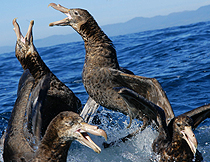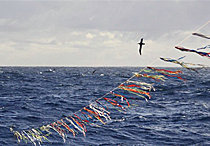A little more than a decade ago, thousands of seabirds — including the magnificent wandering albatross, with the longest wingspan of any bird in the world — perished annually in the Southern Ocean surrounding Antarctica when they dove for baited hooks set by longline fishing boats. Impaled on the hooks, the birds were dragged underwater and drowned.
But in recent years, increased regulations, stricter enforcement, and innovative gear — including the adoption of technologies that weigh down baited hooks well below the surface or scare seabirds away from longlines — have had a dramatic impact on so-called seabird bycatch. The number of drowned seabirds in the Southern Ocean surrounding Antarctica has fallen to near zero in the legal fishery, experts say. Another key factor was a requirement by the Commission on the Conservation of Antarctic Marine Living Resources that a scientific observer be placed on every fishing boat operating in the Southern Ocean.
“Where environmental organizations, fishery managers, and fishermen work together — great results have been achieved,” says Ramunas Zydelis, a seabird expert with the Center for Marine Conservation at Duke University. “Seabird bycatch has been reduced by 90 percent and more in longline
The number of seabirds drowned by longline fisheries remains hugely unsustainable.fisheries in the Southern Ocean, Hawaii, Alaska, South Africa, and New Zealand.”
Such efforts are sorely needed, as the number of seabirds drowned by longline fisheries — estimated at 160,000 to 320,000 annually — remains hugely unsustainable. This toll is emblematic of a wide array of threats facing seabirds today. Having navigated the perils of marine life for 65 million years, seabirds face unprecedented challenges, particularly from industrial fisheries.
Two recent studies have highlighted the intensifying pressure on the world’s seabirds. A recent paper in Bird Conservation International noted that 28 percent of the world’s 346 seabird species are listed as threatened by the International Union for Conservation of Nature’s Red List — more than double the percentage of birds imperiled as a whole (12 percent). The study concluded that nearly half — 47 percent — of the world’s seabirds are in decline.

Â
Scientists say the decline in seabird populations is a warning sign of a broader assault on the world’s oceans, from overfishing, to pollution, to climate change.
“Seabirds are found across all of the world’s oceans, are well-known, relatively easy to monitor, and are sensitive indicators of ocean health,” explains Stuart Butchart, co-author of the Bird Conservation International paper and global species officer with the conservation group, BirdLife International. “They act as the marine equivalent of canaries in the coal mine because they respond to many of the most important threats to the marine environment.”
Solutions to Bycatch
While tackling the broader problem of overfishing has proven exceedingly difficult, doing something about seabird bycatch has proven to be a more tractable problem. Fisheries agencies such as the U.S. National Oceanic and Atmospheric Organization (NOAA) and conservation groups such as the World Wildlife Fund (WWF) — which for the past seven years has sponsored the International Smart Gear Competition to reduce bycatch of seabirds and other species — have been working with fishermen and enjoying success where regulations are enacted.
The main culprit is longline fisheries, which spool out fishing lines up to 80 miles long that are baited with thousands of hooks. Currently 40 of the world’s seabird species are killed as bycatch, including those most
Currently 40 of the world’s seabird species are killed as bycatch.connected to the open ocean: albatrosses and petrels.
How do you make bait less attractive to seabirds? Common methods include using weighted lines that sink below the surface or attaching streamers to longlines — known as tori lines — to scare off birds. Shifting how and when fisheries work also is important, such as setting lines in low light when birds are less active or no longer throwing offal, or chum, when setting lines.
Pamela Toschik, an international affairs specialist with NOAA, says marine researchers refer to these methods as “shrink and defend” — shrink the area in which the hooks are available by weighting the lines so the baited hooks sink faster, and then defend the remaining area with bird-scaring lines. She and others said that independent scientific observers also are vital to collecting data on lone boats that ply the sea thousands of miles from enforcement agencies.
An anonymous observer who did several tours on longline fisheries in the Pacific says ships used several methods to mitigate bycatch, including dying bait blue for camouflage. The observer said that while mitigation procedures have had a “huge” impact on reducing seabird bycatch, several albatrosses drowned on the ships where she was stationed. “These vessels set upwards of 2,000 hooks per day, each having the capability to catch a fish — or a bird, turtle, or whale,” said the observer. “It’s impossible to control for all conditions.”

Â
Researchers are now working to reduce seabird bycatch from gillnets, a largely unstudied and unmitigated threat. Experts believe that hundreds of thousands of diving seabirds — such as loons, grebes, seaducks, auks, cormorants, and shags — drown in gillnets every year. Gillnets ensnare diving birds when they are attracted to floundering fish. Duke’s Zydelis says knowledge of gillnet seabird bycatch remains “patchy” because the nets are operated by thousands of small-scale fishermen. But he said that once researchers begin monitoring the threat, mitigation methods could be rapidly developed; already, some fishermen have employed more visible nets and moved them to areas where seabirds are less likely to become entangled.
“Fisheries should learn that adoption of minor changes in methods can save seabirds, while at the same time create more efficient operations that help their bottom line,” says Stephen Kress, the Audubon Society’s vice president for bird conservation. “There is great value in educating fishers about this win-win opportunity.”
Overfishing: A third for the birds
A more daunting challenge is overfishing of seabirds’ prey species. The recent study in Science found that not only are seabird populations intrinsically connected to prey abundance, but also documented for the first time at what level overfishing begins to hurt these slow-breeding birds. Looking at 14 seabird species in seven marine ecosystems, scientists discovered that every time prey populations dropped below one third of their maximum abundance, seabird breeding suffered.
“What this is saying is that [seabirds] have evolved to exploit average to above-average feeding conditions,” says co-author Ian Boyd, director of the Scottish Oceans Institute at the University of St. Andrews. “This isn’t really very surprising, but some things don’t become obvious until the evidence is right in front of you.”
The research incorporated everything from penguins to gannets, as well different prey species. One case involves the Peruvian anchovy fishery. Boyd says that there is circumstantial evidence of “long, sustained declines of seabirds as the fishery has grown,” although scientists lack conclusive data directly linking the fishery to seabird declines. Penguin expert David Ainley, a senior marine wildlife ecologist with H.T. Harvey & Associates, says that anchovy fisheries have put several penguin species at risk.
“This is especially true of the African penguin and the Humboldt penguin in the Benguela and Peru currents, respectively, where the fisheries for anchovies are immense and have led to the severe depression in almost all seabird species breeding along those coasts,” Ainley said in an e-mail, noting that the Humboldt penguin is also a victim of drowning in gillnets.
‘Anchovy fisheries are immense and have led to severe depression in seabird species breeding along those coasts,’ says one expert.Ainley said the best solution is to create marine protected areas encompassing much of the foraging range of these seabird species.
Bycatch and overfishing are not the only threats to the world’s seabirds. Pollution — from dumped plastics to nitrogen runoff to oil spills — also has detrimental impacts on seabirds. Invasive predators on breeding islands are another problem, but one where conservationists are making significant progress; Scientists have successfully eradicated invasive rodents from 284 breeding islands, though at least 75 islands still require such efforts. Finally, climate change is threatening to swamp low-lying breeding islands and possibly impact prey abundance.
Boyd and his co-authors argue that their findings should propel a new way of thinking about fisheries management, with a rallying cry of “one third for the birds” — not just to preserve seabird abundance but to help other species as well.
“It is possible that the relationship also applies to many components of the ecosystem,” says Boyd. “If this was used as a general rule in fisheries it is more likely to lead to sustainable fishing than current systems of management.”
MORE FROM YALE e360
The Vital Chain: Connecting The Ecosystems of Land and Sea

“Managing fisheries unsustainably not only denies future generations of people from using these food supplies, but also has detrimental impacts on other biodiversity,” Butchart says. “Ensuring that harvesting is sustainable provides long-term benefits both to people and nature.”
For biologist Carl Safina — author of Eye of the Albatross and president of the Blue Ocean Institute — the reasons to protect seabirds go well beyond the practical. Says Safina, “They are exquisitely beautiful, they are extreme athletes, and their travels and migratory skills inspire awe.”